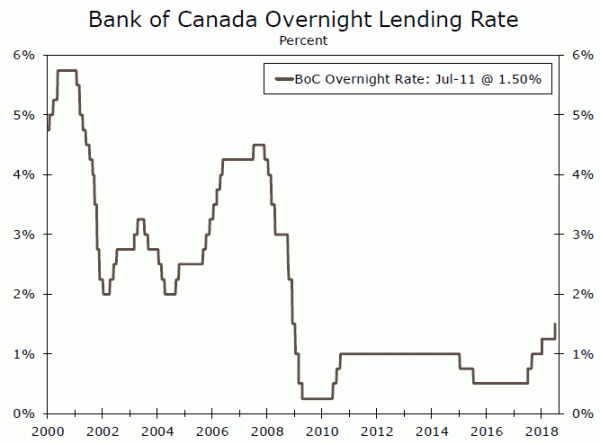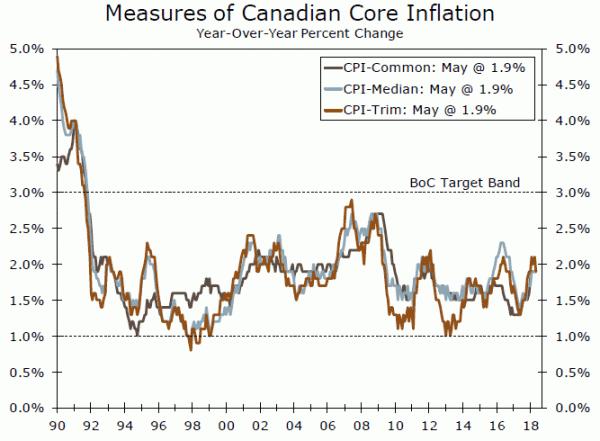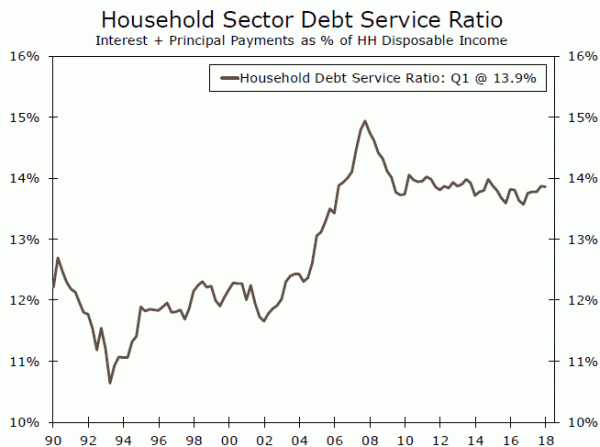The Bank of Canada (BoC) raised the overnight lending rate 25 bps to 1.50 percent, marking its fourth hike in the past 12 months. The pace of hikes is likely to slow ahead as trade risks loom..
Fourth Rate Hike in 12 Months as Economy Firms
For a fourth time in the past year, the BoC hiked rates 25 bps, bringing the overnight lending rate to 1.50 percent (top chart). Markets widely expected the move, given firming inflation and other signs of an economy close to capacity. Core measures of inflation are near the middle of the BoC’s target range and headed higher (middle chart). A weaker Canadian dollar, which has fallen in the wake of trade concerns, and new tariffs on U.S. imports will add upward pressure to inflation, along with growing capacity constraints.
Solid wage growth reflects a tightening labor market. Average hourly earnings growth reached 3.9 percent year over year in May, the highest rate since 2009, and has come in above 3.0 percent every month so far in 2018. Employment growth has been weaker, with total employment down 17,000 jobs from December 2017. However, the decline is limited to parttime employment; full-time employment is up 85,000 jobs.
Output growth is also picking up. Canadian GDP grew only 1.3 percent annualized in Q1, a downshift from growth of 4.0 percent in Q1-2017. However, we expect Q1 to be the weakest quarter of the year, due to higher oil prices, stronger export growth and a stabilization in residential investment. Stronger monthly growth puts GDP on track to expand above 2.0 percent in Q2, at the upper end of Canada’s potential GDP growth range of 1.5-2.1 percent as calculated by the BoC. Growth faster than the long-term sustainable rate should further reduce spare capacity in the economy.
Trepidation for the Path Ahead
Trade uncertainty is the most immediate risk to an otherwise solid outlook for the Canadian economy. The BoC noted in today’s press release that the effect of trade uncertainty on Canadian investment and exports is likely to be larger than it originally estimated, and that “the possibility of more trade protectionism is the most important threat to global prospects.”
Canada sent 76 percent of its goods exports to the United States in 2017, and exports make up almost a third of Canadian GDP. Therefore, escalating trade tensions with its southern neighbor could have a significant effect on growth. Beyond their direct effect on export volumes, trade tensions are also starting to weigh on business investment, according to the BoC.
Policymakers have long anticipated a pivot to business investment and exports as drivers of Canadian growth, relieving the highly leveraged Canadian consumer of its position at the helm. However, trade risks may leave households in charge for a while longer. We will be watching the household debt service ratio (bottom chart) for signs that rising interest rates are starting to limit the ability of consumers to maintain spending.
We expect the BoC to hike once more in 2018, with risks tilted to the downside.
















